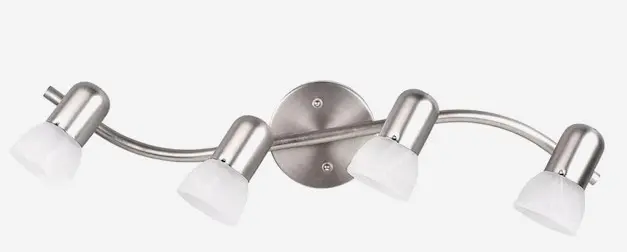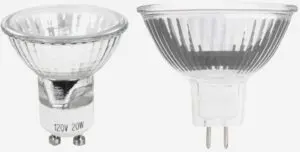Different light bulbs used in track lighting

Introduction
Hi there. This article is about the light bulb types for track lighting.
Firstly I look at what track lighting is and the different types available.
Then I take a survey of the different light bulb types track lighting uses.
Finally I discuss some features of these different bulbs types.
Hopefully by the end of this article you will know more about track lighting and the light bulb types it uses.
What is Track Lighting
In brief track lighting is lighting connected to a bar or rail. The bar or rail is the track. Also, it can be straight or curved. And there can be one light bulb or many connected to the track.
For example in the photo at the start of this article. This is a linear (because it is straight) track with 3 track lights attached.
Additionally, track lighting may contain a voltage transformer. This is a device that reduces the voltage down from the standard 120 volts. In the case of track lighting it reduces it to 12 volts. As we will see, a number of track light bulbs run at this lower voltage.
What are the Different Types of Track Lighting

So, to recap, track lighting has a rail or rod called the track. The track has a number of light fittings connected to it.
There are three main types of track. Namely, linear, flexible and fixed.
Linear, as the name suggest is straight. Normally it comes in in 4- and 8-foot lengths. So, you can extend the size of the track to add more lights.
Conversely flexible is anything that is not straight. Lots of the more decorative track lighting is flexible. For example the track lighting kit in the photo above has a curved track. Flexible track lighting comes in lots of decorative shapes.
Finally fixed track lighting has a fixed number of lights attached to it and cannot be extended. On the whole the track is straight but it can also be circular or curved.
As can be seen there is some overlap in these definitions. However to summarize, linear is extendible and straight, fixed cannot be extended and flexible is decorative and not straight.
Linear and Fixed Track Lighting Heads
In general all track lighting has attached light sockets called lighting heads.
For linear and fixed track lighting there are four main types:
- Step Head. Where the back of the head is thinner than the front, giving it a step in the middle.
- Round Back Head. Where the back of the head is round
- Pinhole Head. Where the head has holes at the back, giving it an open feel.
- Gimbal Head. Where you can angle the head.
Flexible track lighting also uses these head types as well as more decorative and specialist shapes.
Light Bulbs Types Used in Track Lighting
Finding Out The Light Bulb Types
As has been noted there are lots of different mixes of tracks, heads and bulbs available. In order to work out what the main ones are I looked at Lowes website. Because the website provides bulb types and counts for its different track offerings.
Results
As can be seen below Lowes splits its track lighting into fours sections.
Fixed Track Lighting Kits
| Bulb Type | Count |
|---|---|
| GU10 base | 144 |
| Integrated bulbs | 102 |
| Medium base (E26) | 59 |
| G5.3 base | 12 |
Linear Track Lighting Kits
| Bulb Type | Count |
|---|---|
| MR16 bulb type | 72 |
| GU10 base | 16 |
| A19 bulb type | 9 |
| R30 bulb type | 9 |
Flexible Track Lighting Kits
| Bulb Type | Count |
|---|---|
| MR16 bulb type | 22 |
| A19 bulb type | 4 |
| A15 bulb type | 4 |
| PAR30 bulb type | 2 |
So, What Are The Bulb Types?
MR16, GU10 and GU5.3
Firstly a little bit about MR16 bulb types and GU bases. I dedicated a blog post to the confusion between GU10 and MR16. And have summarized the details below.

In brief GU10 an GU5.3 are connectors. GU stands for General Usage and the number is the distance between the connectors in millimeters. That is 10mm (0.04 inches) and 5.3mm (0.2 inches).
In general both of these connectors are attached to MR16 bulbs. That is, MR is the bulb type, standing for multifaceted reflector. Also the 16 stands for 16 / 8th of an inch (2 inch) diameter.
So, why is there a problem? Basically over time people started to refer to the MR16 bulbs with the GU5.3 connect as MR16s. By the same token MR16s with the GU10 started getting called simple GU10.
In fact both of them are MR16 bulbs, one with a GU10 base and the other with a GU5.3 base.
Additionall the two different connectors take different voltages. On account of GU5.3 bulbs using 12 volts. While GU10 connected bulbs take the standard 120 volts.
So take care when buying track light bulbs. in particular check the connectors and voltage requirements.
Bulb Types Used
On the whole fixed track lighting takes MR16s with a GU10 base. Also a small number of MR16s with the GU5.3 base that take 12 volts.
Conversely linear track mainly takes MR16s with the GU5.3 12-volt base.
Also across all track types we see a smattering of medium base bulbs. Such as A15, A19, R30 and PAR30. In fact there are lots of normal light bulbs that can fit in the medium E26 screw base. Owing to it being the standard light bulb base.
However, track lighting works as spot and flood lighting. In brief lighting up a particular area. Thus the bulbs most frequently used are reflectors that provide a focused light. Such as the R and PAR (Reflector and Parabolic Aluminized Reflector) we saw earlier.
In Conclusion
So, hopefully this article has given you a good idea of the light bulb types used for track lighting.
To summarize, the main bulb type is MR16 split across the two different connector types GU10 and GU5.3.
In light of the confusing use of the terms GU10 and MR16 make sure you check your bulb requirements carefully.
Additionally, a small number of track head take medium screw bulbs, normally reflectors.